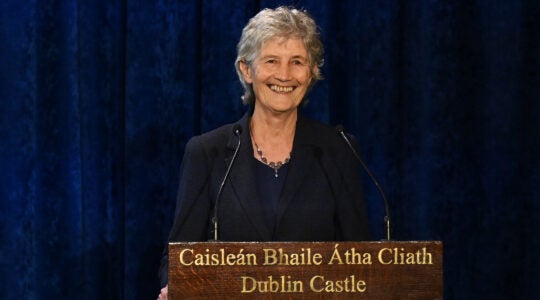
U.S. college students preparing some cement as part of a restoration project for a Belarus Jewish cemetery, 2012. (Restoration of Eastern European Jewish Cemeteries Foundation)
(JTA) — Every month or so, a highly emotional email lands in the inbox of Martin Kornfeld, CEO of the Federation of Jewish Communities in Slovakia.
The authors invariably are Western tourists appalled by the neglect they witnessed during visits to one of the hundreds of Jewish cemeteries scattered across the country. Often their emails concern the final resting place of their relatives amid overgrown grasses and overturned tombstones.
“They want us to fix it,” Kornfeld told JTA. “But ours is a small and not wealthy community that prioritizes the living.”
Across Eastern Europe, hundreds of Jewish cemeteries are disintegrating as the small communities entrusted with their care focus their limited resources on reestablishing a living presence after long years of communist suppression and the near annihilation of the Holocaust.
Following the fall of communism in the early 1990s, control of cemeteries in several countries of the former Eastern bloc reverted to the Jewish community. In Slovakia, Poland, the Czech Republic and elsewhere, this resulted in communities of a few thousand people suddenly becoming responsible for vast burial grounds that before the Holocaust had been administered by congregations dozens of times larger. Some 90,000 Jews lived in Slovakia before the war; today the community numbers about 3,000.
“Out of 750 Jewish burial grounds in Slovakia, we can afford to take care of only 150 — and even that is a major burden,” Kornfeld said. “The cemeteries can drain tens of thousands of dollars from a budget stretched to cover the senior home, kindergarten, summer camps — the trappings of a living, breathing community.”
In neighboring Poland, a Jewish community that once numbered 3.5 million has been reduced to about 40,000. Michael Schudrich, the country’s chief rabbi, says fences are crucial to preventing the country’s 1,400 Jewish cemeteries from turning into trash heaps, but the cost of erecting one has multiplied. Only about 100 of Poland’s cemeteries are fenced, Schudrich said, and fencing the rest requires $32 million.
“It’s a constant drain of money,” said Piotr Kadlcik, president of the Union of Jewish Communities in Poland. “Without fences, the area quickly becomes a dumpster. Then the city fines the Jewish community.”
Last year, the Council of Europe adopted a nonbinding resolution placing responsibility for the care of Jewish cemeteries on national governments. The resolution was based in part on a report by the special rapporteur for Jewish cemeteries, Piet de Bruyn, who wrote that Jewish cemeteries are “probably” more vulnerable because of the small size of the communities. The report also noted instances of cemeteries in Eastern Europe that have been turned into “residential areas, public gardens, leisure parks, army grounds and storage sites; some have been turned into lakes.”
Moshe Kantor, the president of the European Jewish Congress, says governments should cover the costs of preserving Jewish cemeteries as they would other aspects of their cultural heritage. He noted that Lithuania’s Jewish community was declining to reassert control over its cemeteries because it fears the financial burden of upkeep.
In the 1950s, West Germany agreed that the preservation of “orphaned Jewish cemeteries” was the responsibility of local and federal authorities. But most European countries accept no such responsibility. Jewish leaders generally see the preservation of cemeteries as a communal obligation.
It is “first and foremost a challenge for the Jewish world,” Schudrich said. “We, the communities, can provide the administration, but the Jewish world needs to provide the funds.”
In Slovakia, the community has launched an online campaign, SOS Cemeteries, which allows donors of $650 or more to sponsor preservation work in a cemetery of their choosing. The program, which was set up to engage Western tourists, has yet to generate much income, but Kornfeld hopes revenues pick up once word gets out.
In Poland, prison authorities and the Foundation for the Preservation of Jewish Heritage in Poland launched a program in 2010 in which prisoners help clean up several Jewish cemeteries. Local villagers also have become involved, often at the initiative of local governments.
In New York, Michael Lozman, an orthodontist whose parents were born in Belarus, founded the Restoration of Eastern European Jewish Cemeteries Foundation, which has brought hundreds of American college students to restore cemeteries in Belarus and Lithuania with money raised from private donors. The students spend two weeks restoring one or more Jewish cemeteries along with non-Jewish local students.
“Working with locals to preserve cemeteries achieves much more than meets the eye,” Lozman told JTA. “It educates young people about their country’s Jewish heritage and the Holocaust, and creates in them a commitment to the Jewish cemetery and by extension the Jewish past. Ultimately, the long-term survivability of the cemetery depends largely on them.”
Ultimately, however, such efforts are just a drop in the bucket. In Raslavice, in eastern Slovakia, money from SOS Cemeteries helped pay for a new fence at the cemetery there. But the cemetery is still overgrown, and visiting Jewish tourists are still lodging their complaints — and offers of help.
“May G-d bless you for this amazing job,” Zvi Ziegler, an Israeli with ancestors buried in Raslavice, wrote to the community last year. “On the other hand, unfortunately, the grave sites were inaccessible due to the vegetation which covered and hid all the matzevot [headstones]. I understand that to maintain these holy sites costs money, and I’m willing to contribute toward this expense.”
JTA has documented Jewish history in real-time for over a century. Keep our journalism strong by joining us in supporting independent, award-winning reporting.





